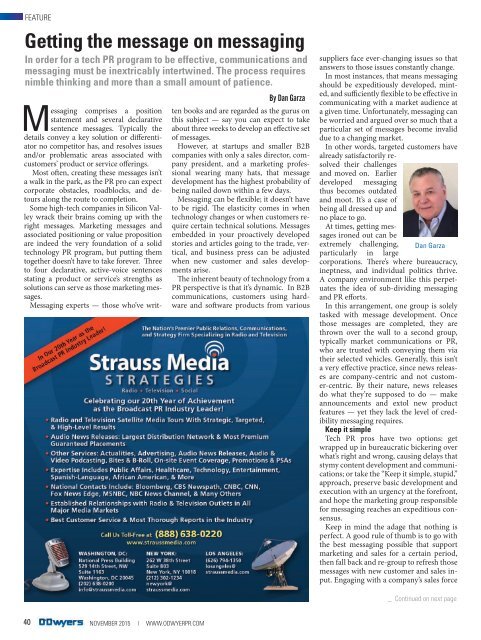Communications & New Media Nov 2015 Vol 29 No 11
odwyers-magazine-november-2015
odwyers-magazine-november-2015
You also want an ePaper? Increase the reach of your titles
YUMPU automatically turns print PDFs into web optimized ePapers that Google loves.
FEATURE<br />
Getting the message on messaging<br />
In order for a tech PR program to be effective, communications and<br />
messaging must be inextricably intertwined. The process requires<br />
nimble thinking and more than a small amount of patience.<br />
Messaging comprises a position<br />
statement and several declarative<br />
sentence messages. Typically the<br />
details convey a key solution or differentiator<br />
no competitor has, and resolves issues<br />
and/or problematic areas associated with<br />
customers’ product or service offerings.<br />
Most often, creating these messages isn’t<br />
a walk in the park, as the PR pro can expect<br />
corporate obstacles, roadblocks, and detours<br />
along the route to completion.<br />
Some high-tech companies in Silicon Valley<br />
wrack their brains coming up with the<br />
right messages. Marketing messages and<br />
associated positioning or value proposition<br />
are indeed the very foundation of a solid<br />
technology PR program, but putting them<br />
together doesn’t have to take forever. Three<br />
to four declarative, active-voice sentences<br />
stating a product or service’s strengths as<br />
solutions can serve as those marketing messages.<br />
Messaging experts — those who’ve writ-<br />
By Dan Garza<br />
ten books and are regarded as the gurus on<br />
this subject — say you can expect to take<br />
about three weeks to develop an effective set<br />
of messages.<br />
However, at startups and smaller B2B<br />
companies with only a sales director, company<br />
president, and a marketing professional<br />
wearing many hats, that message<br />
development has the highest probability of<br />
being nailed down within a few days.<br />
Messaging can be flexible; it doesn’t have<br />
to be rigid. The elasticity comes in when<br />
technology changes or when customers require<br />
certain technical solutions. Messages<br />
embedded in your proactively developed<br />
stories and articles going to the trade, vertical,<br />
and business press can be adjusted<br />
when new customer and sales developments<br />
arise.<br />
The inherent beauty of technology from a<br />
PR perspective is that it’s dynamic. In B2B<br />
communications, customers using hardware<br />
and software products from various<br />
suppliers face ever-changing issues so that<br />
answers to those issues constantly change.<br />
In most instances, that means messaging<br />
should be expeditiously developed, minted,<br />
and sufficiently flexible to be effective in<br />
communicating with a market audience at<br />
a given time. Unfortunately, messaging can<br />
be worried and argued over so much that a<br />
particular set of messages become invalid<br />
due to a changing market.<br />
In other words, targeted customers have<br />
already satisfactorily resolved<br />
their challenges<br />
and moved on. Earlier<br />
developed messaging<br />
thus becomes outdated<br />
and moot. It’s a case of<br />
being all dressed up and<br />
no place to go.<br />
At times, getting messages<br />
ironed out can be<br />
extremely challenging, Dan Garza<br />
particularly in large<br />
corporations. There’s where bureaucracy,<br />
ineptness, and individual politics thrive.<br />
A company environment like this perpetuates<br />
the idea of sub-dividing messaging<br />
and PR efforts.<br />
In this arrangement, one group is solely<br />
tasked with message development. Once<br />
those messages are completed, they are<br />
thrown over the wall to a second group,<br />
typically market communications or PR,<br />
who are trusted with conveying them via<br />
their selected vehicles. Generally, this isn’t<br />
a very effective practice, since news releases<br />
are company-centric and not customer-centric.<br />
By their nature, news releases<br />
do what they’re supposed to do — make<br />
announcements and extol new product<br />
features — yet they lack the level of credibility<br />
messaging requires.<br />
Keep it simple<br />
Tech PR pros have two options: get<br />
wrapped up in bureaucratic bickering over<br />
what’s right and wrong, causing delays that<br />
stymy content development and communications;<br />
or take the “Keep it simple, stupid,”<br />
approach, preserve basic development and<br />
execution with an urgency at the forefront,<br />
and hope the marketing group responsible<br />
for messaging reaches an expeditious consensus.<br />
Keep in mind the adage that nothing is<br />
perfect. A good rule of thumb is to go with<br />
the best messaging possible that support<br />
marketing and sales for a certain period,<br />
then fall back and re-group to refresh those<br />
messages with new customer and sales input.<br />
Engaging with a company’s sales force<br />
_ Continued on next page<br />
40 NOVEMBER <strong>2015</strong> | www.ODwyERPR.COM


